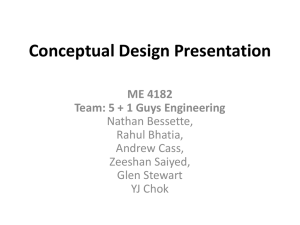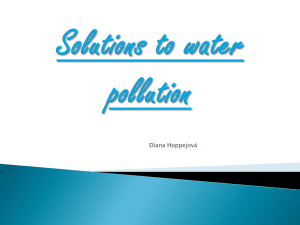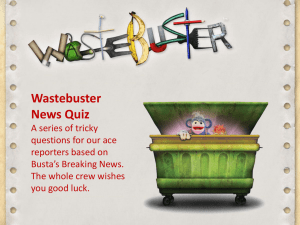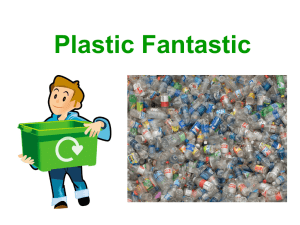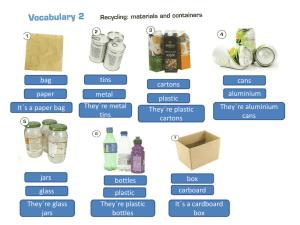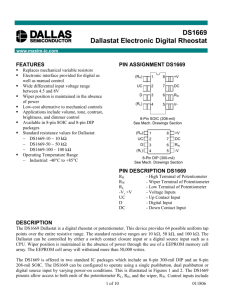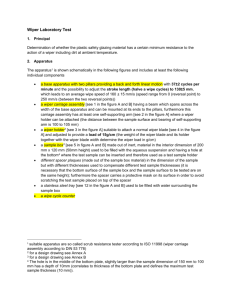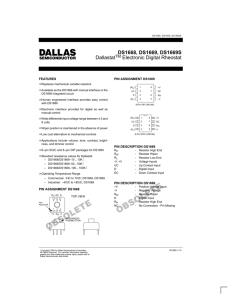IGPG-09-05e
advertisement
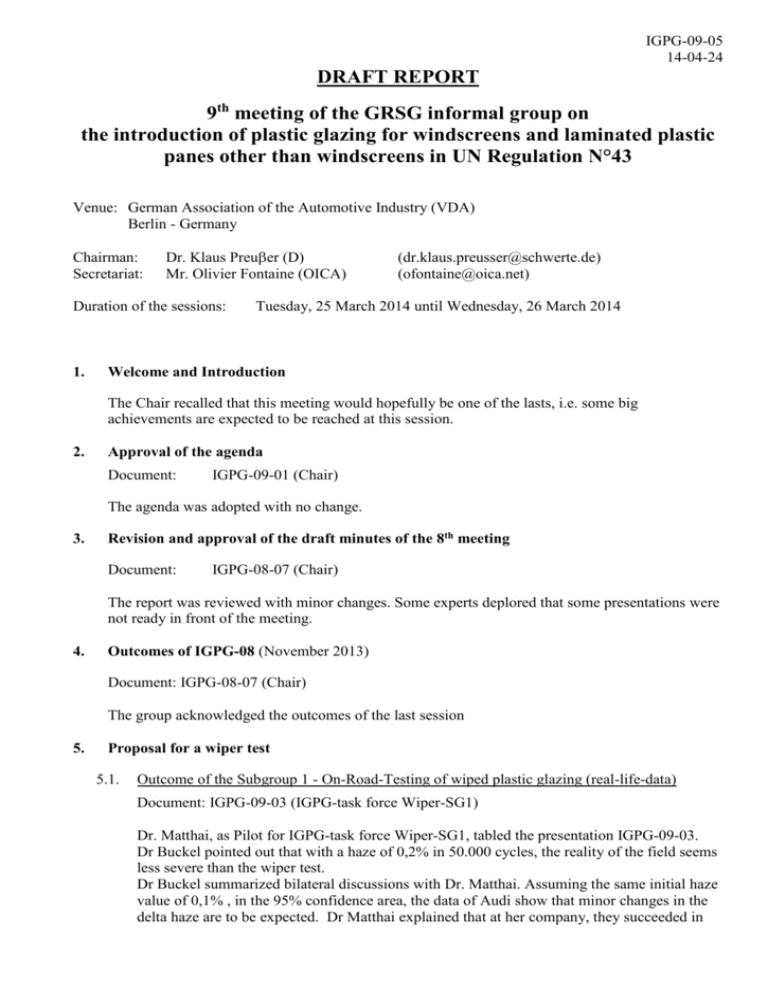
IGPG-09-05 14-04-24 DRAFT REPORT 9th meeting of the GRSG informal group on the introduction of plastic glazing for windscreens and laminated plastic panes other than windscreens in UN Regulation N°43 Venue: German Association of the Automotive Industry (VDA) Berlin - Germany Chairman: Secretariat: Dr. Klaus Preuer (D) Mr. Olivier Fontaine (OICA) Duration of the sessions: 1. (dr.klaus.preusser@schwerte.de) (ofontaine@oica.net) Tuesday, 25 March 2014 until Wednesday, 26 March 2014 Welcome and Introduction The Chair recalled that this meeting would hopefully be one of the lasts, i.e. some big achievements are expected to be reached at this session. 2. Approval of the agenda Document: IGPG-09-01 (Chair) The agenda was adopted with no change. 3. Revision and approval of the draft minutes of the 8th meeting Document: IGPG-08-07 (Chair) The report was reviewed with minor changes. Some experts deplored that some presentations were not ready in front of the meeting. 4. Outcomes of IGPG-08 (November 2013) Document: IGPG-08-07 (Chair) The group acknowledged the outcomes of the last session 5. Proposal for a wiper test 5.1. Outcome of the Subgroup 1 - On-Road-Testing of wiped plastic glazing (real-life-data) Document: IGPG-09-03 (IGPG-task force Wiper-SG1) Dr. Matthai, as Pilot for IGPG-task force Wiper-SG1, tabled the presentation IGPG-09-03. Dr Buckel pointed out that with a haze of 0,2% in 50.000 cycles, the reality of the field seems less severe than the wiper test. Dr Buckel summarized bilateral discussions with Dr. Matthai. Assuming the same initial haze value of 0,1% , in the 95% confidence area, the data of Audi show that minor changes in the delta haze are to be expected. Dr Matthai explained that at her company, they succeeded in IGPG-09-05 having more cycles than the suppliers (up to 50.000). As a summary, plastic glazing shows damage very soon, the Taber test is not relevant for plastic glazing, and some OEMs would reject it. A debate took place on the possible correlation between mileage and lab wiper cycles. It was also found necessary to avoid a comparison with glass, and rzather focus on the absolute quality of plastic glazing with regard to safety. Dr Matthai stressed that OEMs focus on traffic safety, hence optical distortion for example is an important criterion, in particular when the customer is key for the choice of an OEM with regard to optical qualities. OICA pointed out that the OEM internal quality levels should not influence the discussions on Type Approval regulation. Evonik was optimistic that products could evolve, and suggested to put the number of cycles to 20.000. In addition, it is necessary to compare plastic with plastic (hydrophobic vs. hydrophilic) in order to make a correlation between real road tests and lab tests. Hence the correlation factor for glass cannot be used for plastic. Some experts were convinced that the wiper test is more severe for plastic than for glass, but were lacking data to know how much harder. SABIC questioned some choices in the test method (e.g. flow of water poured on the test sample). The spirit of the 58 Agreement was recalled, i.e. the performance tests in a regulation could only simulate the reality, with UN R94 (frontal impact) and UN R83 (pollutant emissions) taken as examples, and the Secretary stressed that durability was an additional criterion added in the case of resistance to abrasion, and already existing in the case of UN R83 (160.000 km durability test). The experts were lacking justifications for the values and test method for the wiper test. Polyplastic proposed that the OEMs focus on the wiper system in addition to the windscreens since the plastic glazing is by nature a hydrophobic material. The group convened that this was out of its mandate, and that progress will happen as from the time the plastic windscreens will be allowed. Rough evaluation of some key figures: Experience Number of cycles Number of km 20.000 150.000 20.000 20.000 1 million BMS 52.000 3000 10.000 8.200 Total Haze Coating 6,1% < 2,5% 0,2 – 0,8% KRD KRD Coating B +/- 1,2% 1,2 % 0,2% 0,2% Coating B Coating B Coating B Coating B comment 1 sample AS4700, Real car (BMW 3-Series) AS4700 AS4700 AS4700 (Golf) AS4700 (Golf) Mr Wiesenberger concluded that the value of 20.000 cycles is more severe than what was experienced in reality. Proposal for a summary of the situation to date Agreed to o Keep Taber test o Add a set of 3 tests as an alternative to Taber test for plastic glazing if the informal group can demonstrate that the set is representative of reality. 2 IGPG-09-05 Comments: Bayer, KRD, Momentive, MPA, Evonik, Polyplastic some OEMs believe the set to be representative Sabic believes the wiper test as shown by SG2 not shown to be representative Final OICA position to be defined Set of 3 tests to be 1) Sand drop 2) Amtec Kistler 3) Wiper test Wiper test to be finalized with regard to o Test method o Number of samples o Pass/fail values Wiper test method: item value Comment Test conditions See document of SG2 (wiper test) Measurement See document IGPG-09-04 Wiper blade can be best adapted to the machine (IGPG-TF Wipe-SG2) (wiper windscreen material. test): Machine Wiper blade Aqueous suspension (with test dust) Test procedure See document IGPG-09-04 (IGPG-TF Wipe-SG2) (wiper test) including expression of the results Number of cycles [20.000] / [50.000] 20.000 in 3 labs (round robin test). 2 days of testing time; i.e. 3 samples = 6 working days (solution supported by the majority) 50.000 in one lab (supported by some OEMs) OICA to make a position for next meeting Informal document to contain [20.000] Number of samples 3 As in the other tests Pass/fail method Hazemeter Pass/fail limits [2] / [0,5] % Delta haze Problem of correlation to mileage. Note: hazemeter precision is 0,8 + need to take account of results distribution. Figure to be confirmed at 10th meeting (June 2014). Considered to be challenging for the coating producers, hence technical progress is expected. 0,5% is supported by some OEMs (50.000 cycles and 0,5% haze). OICA is requested to take a position for June meeting. 3 IGPG-09-05 Some experts from the automotive industry were of the opinion that the values of “20.000 cycles” and “2% haze” could not sufficiently guarantee traffic. 5.2. Outcome of the Subgroup 2 - lab test equipment to test wiper resistance on small samples Final outcomes of data analysis Outcomes of joint meeting (March 2014) Document: IGPG-09-04 (IGPG-TF Wipe-SG2) Dr Buckel presented the outcomes of subgroup 2. The informal group welcomed the results of the SG2. The group furthermore reviewed the proposed test method of the wiper test. Some experts proposed that the choice of the wiper blade be optional to the applicant, such that the test best fits the reality. This principle was agreed by all experts and it was agreed that the wording reflects this possibility. 6. Review of the Taber test Review of ISO group progress Review of the influence of the haze measurement on the results Possibility to reach 5% haze: TI to inform about internal investigation The informal group was informed of the ISO 15082 CD ballot with comments from J: concerns to introduce plastic material reference samples, and proposed to keep the glass reference samples. The ISO group mentioned that the behaviours of the two materials are different; hence glass is no good reference for plastic testing. Yet the problem is whether the plastic samples can be produced with good stability along the years. Then the D industry decided to make a test with PC plastic plates coated with AS4000 by 3 different manufacturers, i.e. with different coating machines, to see whether the PC+AS4000 reference material can be reproduced by different suppliers. A Japanese manufacturer might join the group of the German manufacturers (“coaters”) which will produce coated reference plates. Coating will be applied by each coater with thickness of 5 microns and 10 microns (lower and upper limit), 3 samples each. Taber test will be carried out on those samples by MPA and Pilkington in order to get information about the reproducibility of the coated-plastic reference material. Proposal from D to “qualify” the Taber wheels, then use a correction factor (“two-step process”). This was agreed by the ISO meeting. CD ballot just finalized, DIS ballot to start in August 2014. Whatever the amount of comments, the work cannot be finished before the end of the GRSG-IGPG task; i.e. at the best in mid-2015. Draft report of the meeting will be made available. Next ISO meeting scheduled in October 2014. 7. Laminated rigid plastic windscreens Document: IGPG-08-03 (Chair) Comments from Dr. Dümmler: Page 3: title should read “Annex 1, Appendix 13” Some improvements were agreed in the wording of the indices of difficulties for the secondary characteristics (page 7) and in in the Taber Test (page 8) 4 IGPG-09-05 Some further alignments on document 08-02-Rev.1 were adopted. All experts agreed to the document as changed in the meeting. It was agreed to construct a consolidated document with the 3 existing texts, to be prepared for the 10th meeting of the informal group, then tabled at the 107th session of GRSG (Sept-Oct 2014). 8. Further discussion of the draft regulatory text Document: IGPG-08-02-Rev.1 (Secretary) Some experts raised that paragraph 6.1.3.4. of Annex 18 should be improved in order not to repeat the exemptions now included in Annex 21 per document GRSG/2014/15. Same was recognized for annex 14. The experts discussed the inconsistency in the regulation about the wording and interpretation of the “number of test pieces”. Dr. Dümmler pointed out that this problem can be found in Annexes 14, 16, 17, 18, 19. Current wording of the regulation permits three different interpretations: Samples of 300 x 300 mm, samples cut at 300 x 300 mm from real part or complete Real part. The experts agreed for a further change in paragraph 5.2. of annexes 17, 18 and 19 (Secretariat to do the work). The Chair committed to inform GRSG on the necessity to amend annexes 14 and 16 as well for consistency. But the group agreed not to propose changes at the forthcoming GRSG session. 9. Revision of Annexes 14 and 21 Document: GRSG/2014/15 (F) The experts discussed the document from Germany GRSG-106-02. Concerning paragraph 4.2.2.2., the experts acknowledged that the document GRSG-106-02 was developed by the approval authorities and was already covered by the document GRSG/2014/15. The experts agreed to review internally the proposed wording and to ask the D representative, at the 2nd day of the meeting, the origin, and whether withdrawing the document would be feasible. Note of the Secretariat: This action is still to be conducted. Mr Veeneman was keen that the group confirms full support to document GRSG/2014/15. The group had no further remark. The document GRSG/2014/15 will be presented by F with the support of the informal group. 10. List of action items for next meeting Change in paragraph 5.2. of annex 17, 18, 19 (Secretariat to do the work) Chair to inform GRSG on the necessity to amend annexes 14 and 16 for consistency Consolidated document with the 3 existing texts (Annexes 17, 18, 19) (Secretary and Chair) as an informal document for GRSG-106 Paragraph 6.1.3.4. of Annex 18 should be improved in order not to repeat the exemptions now included in Annex 21 per document GRSG/2014/15. Same was recognized for annex 14. The group agreed not to propose changes at the forthcoming GRSG session OICA to have positions with regard to wiper test for June meeting 5 IGPG-09-05 11. Schedule for further IG meetings GRSG-106 IGPG-10 GRSG-107 Geneva Wolfsburg (Autostadt) Geneva 5-9 May 2014 17-18 June 2014 30 Sept – 3 Oct 2014 12. Any other business __________ 6

